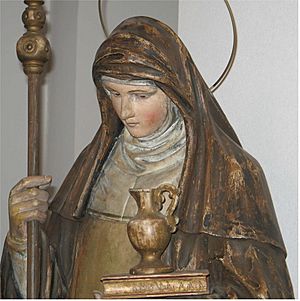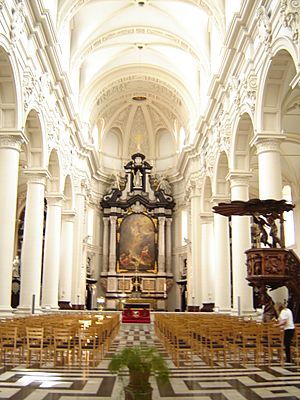Saint Walburga facts for kids

Saint Walpurga (also called Walburga) was an English missionary who traveled to the Frankish Empire (which is now parts of Germany and France). She was born around 710 AD and died on February 25, 777 or 779 AD. Walpurga became a saint on May 1, around 870 AD, by Pope Adrian II.
Her special day, called a "feast day," is celebrated on February 25. People also used to celebrate May 1, the day she became a saint. This day is known as Walpurgis Night in some parts of Europe. It's a traditional night of dancing and celebrations, especially before May Day.
Contents
Her Early Life and Work
Walpurga grew up in England. She had two brothers, Saint Willibald and Saint Winibald. She was taught by nuns at Winborne Abbey in Dorset, England, where she lived for 26 years. This education helped her a lot.
Later, she traveled with her brothers to a region called Francia. This area is now parts of Germany, like Württemberg and Franconia. They went there to help their uncle, Saint Boniface, teach people about Christianity.
Walpurga was a very talented writer. Because of her good training, she wrote a book about her brother Saint Winibald's life. She also wrote a detailed report in Latin about Saint Willibald's travels in a place called Palestine. Many people believe she was the first female author from both England and Germany.
Becoming an Abbess
Walpurga became a nun. She lived in a special kind of monastery called a "double monastery" in Heidenheim, near Eichstätt. Her brother Willibald started this monastery. After Willibald passed away in 751, Walpurga became the leader of the monastery, known as the "abbess."
Walpurga died on February 25, either in 777 or 779. She was buried at Heidenheim. Later, in the 870s, her bones were moved to Eichstätt.
At Eichstätt, her bones were placed in a rocky spot in a wall. People believed that a special healing oil came from her bones. This made many people visit her shrine, hoping for cures.
Walpurga in Art and Culture
The oldest known picture of Walpurga was made in the early 11th century. It comes from a book called the Hitda Codex, created in Cologne. This picture shows her holding stalks of grain.
The grain in her image might show how Christian saints sometimes took over older ideas. In this case, Walpurga might have become linked to the idea of a "Grain Mother," a figure from older beliefs about harvests.
Walpurga is considered the special protector, or "patroness," of several towns. These include Eichstätt, Antwerp, Oudenaarde, Veurne, Groningen, and Zutphen. Many of these towns are in the Low Countries (like modern-day Netherlands and Belgium).
Images for kids
See also
 In Spanish: Walburga para niños
In Spanish: Walburga para niños



